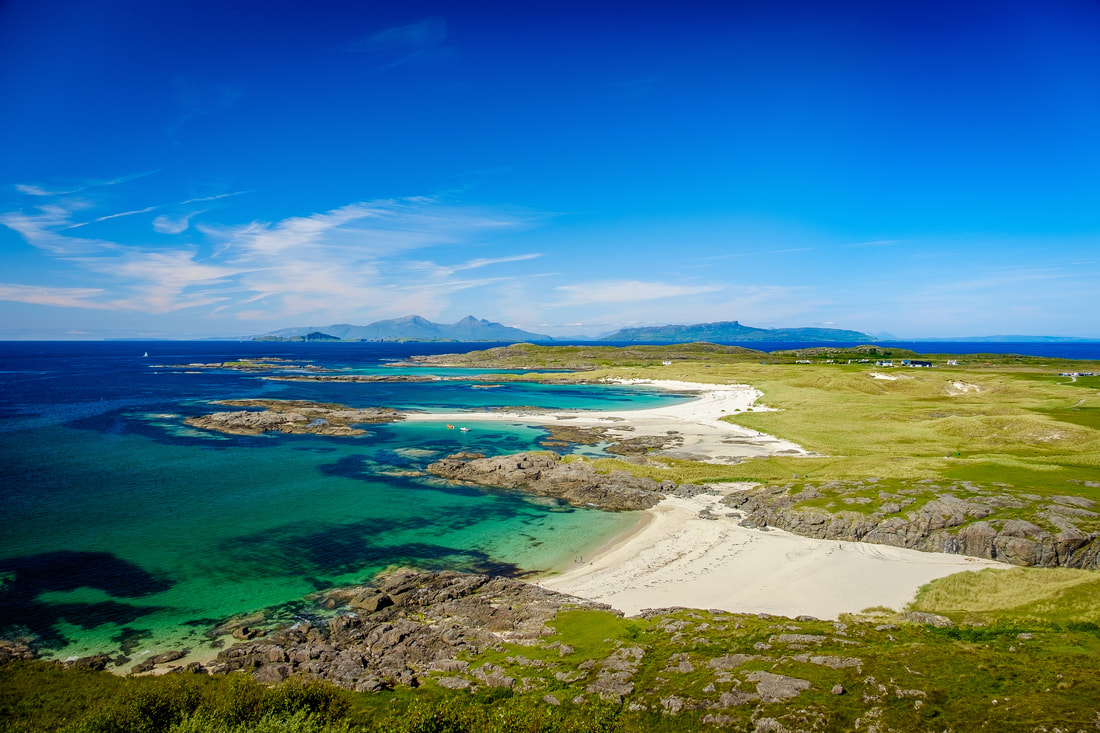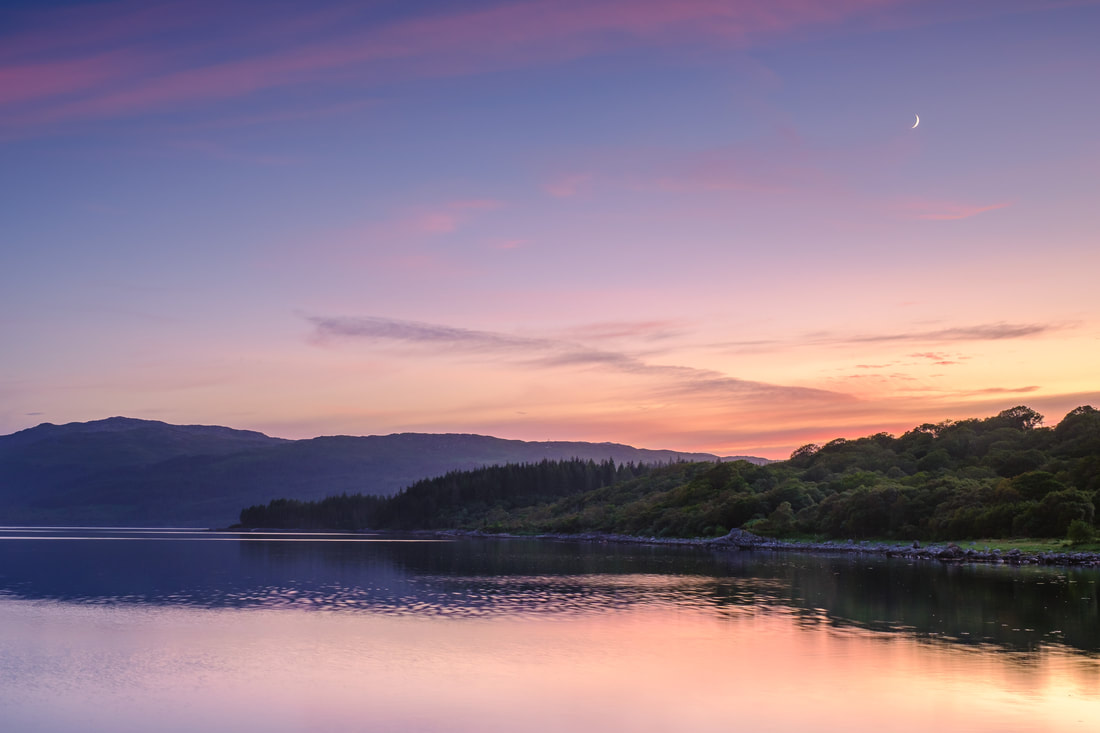|
This month’s thoughts come from a set of six images taken one morning when I decided to explore the boggy ground around the head of Loch Moidart at Ardmolich. I had driven by there the night before on my way to Glenuig and my eye was drawn to a large swathe of cottongrass that covered much of what I could see. This fluffy headed plant is a common sight on the Peninsula from around late May and into midsummer. In many places they are dotted here and there, but occasionally they form more substantial stands such as the one I had spotted and when they do, they are well worth photographing. Despite its appearance, cottongrass, also known as bog cotton or ghost grass is neither cotton or grass. It is in fact a sedge, which is a group of plants that are closely related to grasses. Three species of cottongrass are likely to be found in Scotland: Hare’s-tail Cottongrass, Common Cottongrass and Broad-leaved Cottongrass. All three love damp, acidic environments so are well at home in the peat filled salt marsh that is at Ardmolich. Hare’s-tail cottongrass has just one ‘cotton’ head at the tip of its stem in the form of a tidy, almost spherical tuft, reminiscent of the tail of a rabbit or hare, hence the name. On the other hand, broad-leaved cottongrass and common cottongrass both have several and more unkempt ‘cotton’ heads drooping from their stems that look a bit like cotton wool that has been pulled apart. Having looked at the plants I was photographing, I decided that they were common cottongrass because of the narrow leaves and stems that they had. I wandered around the salt marsh, carefully making my way around innumerable water pools and across countless tussocks until I found myself in the middle of a sea of white, fluffy seed heads gently swaying in the slight morning breeze. I knelt down to take a closer look at the tufts of ‘cotton’ and found myself with an eye level view across the top of them to the hills at the other end of Loch Moidart. It was from there that I took my first photograph, using a long focal length to compress and emphasise the sea of white that floated before me. With the wide perspective shot taken, I focused my time on taking a series of shots that captured the cotton grass in more detail, eventually homing in on a single plant that I was able to isolate from all the others around it by using careful composition and a wide aperture. Coming to the end of doing this, I began to wonder if this fluffy, delicate plant had been used for anything in the past and if it had any folklore associated with it.
Unsurprisingly, one of the primary historic uses of cottongrass was as a stuffing material, particularly by rural communities where resources were limited, and every available material was put to good use. I found references to its downy fibres being used as an insulating stuffing for pillows, mattresses, for lining shoes and even as an absorbent pad for infants to use at night instead of a nappy. When it comes to Scottish folklore, one common theme appears to be the association of cottongrass with the faeries. A number of tales describe cottongrass as one of their favourite plants because they used the soft, fluffy tufts to make their beds, while other tales have described patches of cotton grass swaying gently in the wind as the sight of faeries dancing. However, it is in Shetland where the clearest association of cottongrass and mystical beings exists. It is known locally as Lucka Minnie’s Oo, or wool. A witch from Shetland folklore, Lucka Minnie, was said to roam the hills in summer to collect this wool, which she’d process on a card obtained from the faeries and then use it to knit her clothes. When I tried to find out a bit more about her, I came across two conflicting stories. One described her as a fearful ‘trow’ or troll who met her end while chasing after a young boy who she’d intended to eat for her dinner. The other painted her as a rather benevolent character who would guide lost travellers through treacherous boglands by revealing paths marked by distinctive clumps of cottongrass. I guess that if one were to be true, I hope it would be the latter, which I think would be a fitting tale to link with the delicately beautiful tufts that are the seed heads of the cottongrass.
0 Comments
Despite June being colder than normal, the greening up of the landscape we saw in May was followed by a profusion of wildflowers coming in to bloom to cover the landscape with a multitude of bright colours. This year, it seemed to me that the most prominent amongst them has been the foxglove, with its tall purple spire of bell shape flowers often found rising above dense blankets of bracken that cover the ground from late May onwards. Their size and colour make them visually striking plants and a pair that I found out at Dorlin one morning provided me with the ideal subject on which to anchor this shot of Castle Tioram. While foxgloves, scientifically known as Digitalis purpurea, are undoubtedly striking plants, they are renowned for their potent medicinal properties and have played a key role in treating heart conditions. In the late 18th century, the English physician William Withering discovered that digitalis, an extract from the foxglove, contained digitoxin and digoxin. These two compounds help strengthen and regulate the force of the heart contractions and have been used to treat irregular heartbeats and manage the symptoms of heart failure. In the past, digitalis has had other medicinal uses and was listed in Nicholas Culpeper’s 1652 herbal medicine guide, The English Physician, as a treatment for “the falling sickness”, or epilepsy. One famous person who may have been treated with digitalis for epileptic seizures was Vincent Van Gogh. Many art historians believe that the yellow haze that this would cause in the sight of patients receiving this type of treatment may be responsible for his “yellow period”. This was a time when yellow dominated many of his paintings, and particularly The Starry Night, a painting in which a yellow corona surrounded the moon and each star in it. When it comes to folklore, views are divided on where the common name for Digitalis purpurea comes from. In some parts of Scotland, there is a strong association between the plant and faeries, with foxglove seeming to be a corruption of “folksglove” thus implying that the flowers were the gloves of faeries. In this context it is believed that these gloves are worn by these mystical beings to help them avoid leaving fingerprints when meddling in human affairs. Another myth tells of the foxglove’s bell-shaped flowers being used as little hats or homes by faeries, with children often warned against picking them to avoid offending the fairies who might live inside them and to not bring misfortune upon themselves. Foxgloves were also thought to have protective properties and hanging a sprig of foxglove outside a house was believed to ward off evil spirits and protect the inhabitants from harm. While in some areas, foxgloves were planted around homes and barns to safeguard against witchcraft and to ensure the health and safety of livestock. Alternative folklore suggest that the name “foxglove” comes from the idea that the flowers are the right size and shape for foxes to wear on their paws. According to this legend, foxes, known for their slyness and stealth, would put the flowers over their paws to muffle their footsteps as they hunted or avoided predators. This idea not only highlighted the fox’s cunning nature but also lent an almost magical quality to the foxglove plant, suggesting that it provided some supernatural aid to these clever animals.
Despite living on the Peninsula for several years now, it still often feels like it is a world away from the rest of the country and it is little wonder that summer brings a steady stream of visitors seeking to experience this beautiful, remote, and unspoilt corner of the Scottish Highlands. I often say to visitors that it has a bit of everything that Scotland has to offer, with rugged mountains, beautiful lochs and ancient woodlands, but it is its dramatic and stunning coastline that holds the biggest draw for me and features most in my photography Take this month’s image, which was shot on a beautifully sunny day in July out at Sanna, looking north across the bay to the Small Isles beyond. On days such as this, with bright sunlight overhead, the sea takes on an intense range of blue hues ranging from light blues of the shallow water to the dark blues of the deeper water, all caused by the way light interacts with the seawater.
You see, daylight is made up of many different visible colours, ranging from reds and oranges to blues and violets, with the reds and oranges having the longest wavelengths and the blues and violets having the shortest. As water molecules are better at absorbing light with longer wavelengths, they absorb much of the red, orange, yellow and green light. The bluer colours, with shorter wavelengths, are less likely to be absorbed and so are reflected by the white sand on the seabed to give the sea its blue hues. In shallow water, there are fewer water molecules to absorb the red, orange, yellow and green light, so more of it reaches the seabed to be reflected with the blues and violets and give either clear or slightly blue water. However, the deeper the water becomes, the more the reds, oranges, yellows and greens are absorbed and the deeper blue the colour of the water becomes, until you reach the point where no visible light can reach the seabed and the water becomes completely dark. I find something quite captivating about the aquatic blue hues of the sea at places such as Sanna and I’m sure that this is reflected in my affinity for water and for photographing the sea and the coastline. In fact, it has been documented that our affinity for water is reflected in our near-universal attraction to the colour blue and that we associate this colour with qualities like calm, openness, depth and wisdom. The link between the two has even been developed into something called “Blue Mind Science”, the study of aquatic environments’ health benefits that was first popularised by marine biologist Dr Wallace Nichols in his 2014 book, “Blue Mind”. Simply put, Blue Mind is a mildly meditative state that people fall into when they are near, in, under or on water and some of the physical and mental health benefits include:
So, if you’re seeing red, feeling angry, anxious, and stressed, then head to the coast for some “Blue Mindfulness”. I can highly recommend it. It’s June and summer is finally upon us. This means milder weather and longer days, with the longest day of all taking place on 21 June, the day of the Summer Solstice. As the Sun sets so late and rises so early, it barely gets dark at this time of year. Indeed, this month’s image, which was taken shortly before 11:00 pm on a night close to the Summer Solstice, shows just how light it can be. I spent quite some time then, sitting on a small promontory facing west over Loch Sunart and watching the slimmest of crescent moons traverse the twilit sky as midnight approached. There sure is something magical about these light nights and it is little wonder that the summer solstice and midsummer have been celebrated for time immemorial This year, the summer solstice occurs on 21 June at 10:13 am. It is the exact moment when the North Pole is at its maximum tilt towards the Sun, when the Sun reaches its highest position in the sky and when the Sun rises at its closest to north-east and sets at its closest to north-west.
Although the summer solstice is a precise moment in time, many people refer to it as the “Longest Day” because it is the day when the number of hours of daylight are at their maximum and the number of hours of night are at their minimum. For instance, on 21 June this year, our sunrise here on the Peninsula will be at 4:27:36 am and our sunset will be at 10:22:23 pm, giving us 17 hours, 54 minutes and 47 seconds of daylight. While the summer solstice marks the astronomical start of our summer, it has traditionally been celebrated in Scotland as midsummer, the halfway point in the growing season and a time when people hoped for bountiful harvests. The celebrations began as a Celtic fire festival when bonfires would be used to bless crops and beasts. Animals would be walked around the fire in a sun-wise (clockwise) direction and torches would be lit from the main fire to then be carried around homes and fields, also in a sun-wise direction, to bless families and the crops. Also, people used to gather herbs at this time, and either scatter them into the fire to complete the ritual, wear them along with flowers to ward off evil spirits, or place them under their pillows as good luck charms to manifest good dreams. Birch branches were sometimes hung above doors for protection. This was also believed to be the best time to collect honey from beehives, which is why the first full moon in June was called the “honey moon”. Unsurprisingly, this became the traditional month for weddings. With the coming of Christianity, many pagan midsummer celebrations were moved to the feast of St John the Baptist on 24 June, with bonfires remaining central to them. People would light the bonfires on midsummer eve and then stay up until midnight to welcome in midsummer day. They continued to gather herbs and flowers to protect themselves from evil spirits and one of the most powerful plants was ‘chase-devil’, which is now called St John’s Wort. It was used in potions and woven into garlands because people believed that this would provide them with protection. Finally, herbalists continue to use St John’s Wort in medicines to this day. It contains many chemicals that act on messengers in the brain that regulate mood and there is some strong scientific evidence that it is effective for mild to moderate depression. |
AuthorHi, Archives
July 2024
Categories
All
|
Steven Marshall Photography, Rockpool House, Resipole, Strontian, Acharacle, PH36 4HX
Telephone: 01967 431 335 | Mobile: 07585 910 058 | Email: [email protected]
Telephone: 01967 431 335 | Mobile: 07585 910 058 | Email: [email protected]
All Images & Text Copyright © 2024 - Steven Marshall - All Rights Reserved









